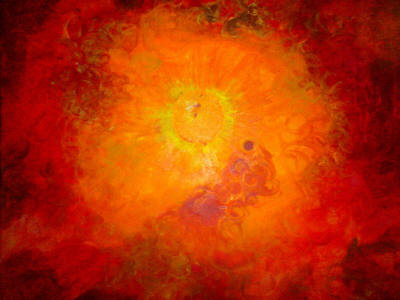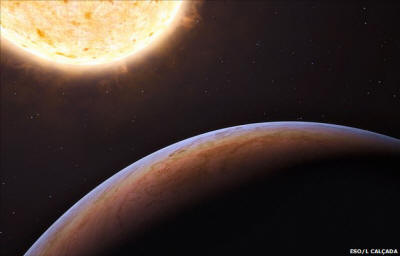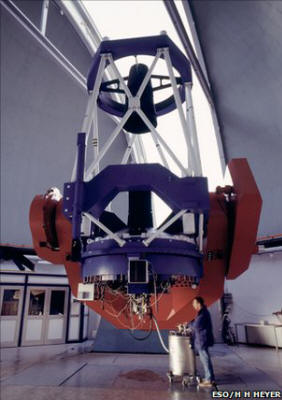|

by Kristen Minogue
18 November 2010
from
ScienceMagazine Website

Improbable
world.
An artist's depiction
of a planet like the one discovered,
caught in the orbit
of an old, violent star.
Astronomers have detected what they
believe to be a planet at least the size of Jupiter that came from
another galaxy.
If true, the world is the first
planetary immigrant ever detected in the Milky Way. The find would
also violate the leading hypothesis of how and where planets form.
The planet lives 2200 light-years away inside the
Helmi stream, a
ring of ancient stars that cuts through the plane of the Milky Way.
Astronomers believe the stream formed 6 billion to 9 billion years
ago, when the Milky Way ripped another galaxy to shreds, swallowing
some of its stars in the process.
Astronomer Johny Setiawan of the
Max Planck Institute for Astronomy in Heidelberg, Germany, likes
looking at these stars because they tend to have unusual properties.
But even by these standards, one star in particular caught his eye:
HIP 13044.
Setiawan and colleagues at Max Planck and the European Space Agency
noticed that the star didn't move at a constant velocity relative to
our sun. Their instruments picked up a regular 16-day pattern, where
sometimes the star was closer and sometimes farther away. That could
be caused by spots on the star, which could confuse velocity
measurements, or by the star expanding and contracting (known as
stellar pulsations).
But the researchers didn't detect
either. That left only one possibility: a planet gravitationally
pulling on the star.
If that's the case, the world is the first foreign planet detected
in the Milky Way, the team reports online today in Science. But
that's not the only unusual thing about it.
It shouldn't have formed
in the first place.
That's because HIP 13044 is a very ancient, very metal-poor star.
It's about 3 billion years older than our own sun and has only 1% as
much metal.
Until now, the prevailing hypothesis has said that as
stars evolve, metals (astronomers' term for any chemical elements
heavier than hydrogen and helium) in the swirling disk around them
form tiny "seeds" that attract other matter and slowly grow into
planets.
So far most surveys have backed up the
theory: Stars rich in metals, such as our Sun, are much more likely
to have planets than stars that don't.
"The fact that you can form planets
around a star that has so little of this material is a very
surprising and unusual thing," says Christopher Johns-Krull, an
astronomer at Rice University in Houston, Texas, who was not
involved in the new work.
But there is a second, more violent,
theory about how planets form.
If the swirling disk of gas is massive
enough - one-tenth the mass of its star or more - Johns-Krull
says the gravitational power of the disk can make the disk unstable.
In those cases, the star isn't big enough to keep the disk in check,
so the disk starts to collapse under its own gravity and forms
planets.
Although it's still not certain that a planet is behind the
variations in the star's speed, all the findings so far point that
way, says NASA astronomer Steven Pravdo. To be sure,
astronomers will need to run other tests.
Ideally, they would look for the planet
to pass in front of the star, but that would work only if the planet
orbits at just the right angle, he says.
"The claim that it's extragalactic
is kind of a guess," says Pravdo.
It's possible the star was originally
part of the Milky Way when it collided with the other galaxy
billions of years ago.
Although an extragalactic planet,
"is a nice possibility," says Pravdo,
the more exciting find is what this planet could do to the idea
of tame, gradual planet formation.
Johns-Krull agrees.
"This planet says, maybe that's not
right," he says. "Maybe it's this other, more dramatic process."
'Alien' Planet Detected Circling Dying Star
by Neil Bowdler
Science reporter, BBC News
18 November 2010
from
BBC Website

This artist's
impression shows HIP 13044 b,
an exoplanet orbiting
a star that entered our galaxy, the Milky Way, from another galaxy
This artist's
impression shows HIP 13044 b,
an exoplanet orbiting
a star that entered the Milky Way from another galaxy
Astronomers claim to have discovered the
first planet originating from outside our galaxy.
The Jupiter-like planet, they say, is part of a solar system which
once belonged to a dwarf galaxy. This dwarf galaxy was in turn
devoured by our own galaxy, the Milky Way, according to a team
writing in the academic journal Science.
The star, called
HIP 13044, is nearing the end of its life and is
2000 light years from Earth.
The discovery was made using a telescope in Chile.
Cosmic cannibalism
Planet hunters have so far netted nearly 500 so-called "exoplanets"
outside our Solar System using various astronomical techniques.
But all of those so far discovered, say the researchers, are
indigenous to our own galaxy, the Milky Way.
This find is different, they say, because the planet circles a sun
which belongs to a group of stars called the "Helmi stream" which
are known to have once belonged to a separate dwarf galaxy.
This galaxy was gobbled up by the Milky Way between six and nine
billion years ago in an act of intergalactic cannibalism.
The
new planet is thought to have a minimum mass 1.25 times that of
Jupiter and circles in close proximity to its parent star, with an
orbit lasting just 16.2 days.

The exoplanet was detected by a European team of astronomers
using
the MPG/ESO 2.2-meter telescope at ESO's La Silla Observatory in
Chile
The exoplanet was detected by a team using the MPG/ESO 2.2-m
telescope in Chile
It sits in the southern
constellation of Fornax.
The planet would have been formed in the early era of its solar
system, before the world was incorporated into our own galaxy, say
the researchers.
"This discovery is very exciting," said Rainer Klement of the Max
Planck Institute for Astronomy in Heidelberg, Germany, who targeted
the stars in the study.
"For the first time, astronomers have detected a planetary system in
a stellar stream of extragalactic origin. This cosmic merger has
brought an extragalactic planet within our reach."
Dr Robert Massey of the UK's Royal Astronomical Society said the
paper provided the first "hard evidence" of a planet of
extragalactic origin.
"There's every reason to believe that planets are really quite
widespread throughout the Universe, not just in our own galaxy, the
Milky Way, but also in the thousands of millions of others there
are," he said, "but this is the first time we've got hard evidence
of that."
End Days
The new find might also offer us a glimpse of what the final days of
our own Solar System may look like.
HIP 13044 is nearing its end. Having consumed all the hydrogen fuel
in its core, it expanded massively into a "red giant" and might have
eaten up smaller rocky planets like our own Earth in the process,
before contracting.
The new Jupiter-like planet discovered appears to have survived the
fireball, for the moment.
"This discovery is particularly intriguing when we consider the
distant future of our own planetary system, as the Sun is also
expected to become a red giant in about five billion years," said Dr
Johny Setiawan, who also works at the Max Planck Institute for
Astronomy, and who led the study.
"The star is rotating relatively quickly," he said. "One explanation
is that HIP 13044 swallowed its inner planets during the red giant
phase, which would make the star spin more quickly."
The new planet was discovered using what is called the "radial
velocity method" which involves detecting small wobbles in a star
caused by a planet as it tugs on its sun.
These wobbles were picked up using a ground-based telescope at the
European Southern Observatory's
La Silla facility in Chile.
Extragalactic Exoplanet
...Found
Hiding Out in Milky Way
by Ron Cowen
Science News Email Author
November 18, 2010
from
Wired Website

Some extrasolar planets are truly out of
this world.
Astronomers have for the first time
discovered a planet in the Milky Way that came from another galaxy.
The planet, which has a mass of at least 1.25 Jupiters, orbits an
elderly star that was ripped from a small satellite galaxy some 6 to
9 billion years ago.
Johny Setiawan and Rainer Klement of the Max Planck
Institute for Astronomy in Heidelberg, Germany, describe the finding
online November 18 in Science.
“The coolness factor is definitely
that the planet and star came from another galaxy,” says Sara
Seager of MIT, who was not part of the study. “The planet almost
certainly formed during the time the star was in the other
galaxy.”
In hunting for extrasolar planets,
Setiawan and his colleagues homed in on
HIP 13044, about 2,000 light-years
from Earth, because it’s part of a stream of stars called Helmi,
believed to have originated in another galaxy.
The star’s motion could also be
monitored for many months each year with a spectrograph at the
European Southern Observatory’s La Silla site in Chile, looking for
telltale wobbles that would indicate the tiny tug of an unseen,
orbiting planet.
HIP 13044 and the other stars in the Helmi stream stand out in the
solar neighborhood because they have elongated orbits that take them
about 42,000 light-years above and below the plane of the Milky
Way’s disk. Such orbits strongly suggest the stars were part of a
group torn from a satellite galaxy and stretched out by
gravitational tidal forces into a filament or stream.
The discovery, notes planet hunter Scott Gaudi of Ohio State
University in Columbus,
“is doubly weird: It is a weird
planet around a weird star.”
The star is unusual because it has the
lowest abundance of metals - about 1 percent of the sun’s - of any
star known to have a planet. (In astronomical parlance, a metal
refers to any element heavier than helium.)
The vast majority of the roughly 500
extrasolar planets known are found around stars with a much higher
metal abundance, and the leading theory of planet formation suggests
that stars with high metal contents are those that form giant,
Jupiter-like planets.
Also unusual is that HIP 13044 is old enough to have exhausted its
supply of hydrogen fuel and passed through the red giant phase of
evolution, in which it mushroomed in size. Since then the star
contracted to a diameter about seven times that of the sun and is
now burning helium at its core. A star in this phase of evolution,
known as the red horizontal branch, has never before been found to
have a planet.
In part, that’s because the enhanced activity of old, evolved stars,
including the presence of magnetically driven disturbances known as
starspots, makes it more difficult to discern a stellar wobble, says
Setiawan.
In addition,
“there is a high risk that you will
not find any planets because they have been engulfed by the star
during the [red giant] evolutionary phase,” he adds.
In order to survive, HIP 13044’s planet,
which now resides much closer to the star than Mercury does to the
sun, must have originally orbited at a much greater distance, the
researchers say.
That’s the only way it could have
escaped being swallowed during the time the star was a red giant.
(In several billion years, the sun will also become a puffed-up red
giant and is likely to engulf Earth and the other inner planets.)
Other planets that resided closer to HIP 13044 would not have been
so lucky.
One explanation for the star’s
relatively rapid rate of rotation is that it has been spun up by the
angular momentum of planets it swallowed. Other rapidly rotating,
elderly stars that have evolved to the red horizontal branch may
have had similar dining habits, researchers have previously noted.
Even though the newfound planet has dodged one bullet, it will soon
face another. In a few million years, when the star exhausts all the
helium forged at its core, it will undergo a more rapid and larger
expansion in which the planet is likely to be destroyed.
Planet From Another Galaxy Discovered
by
Best0fScience
November 18, 2010
from
YouTube Website
|
ESOcast is produced
by
ESO, the
European Southern Observatory.
ESO, the European
Southern Observatory, is the pre-eminent
intergovernmental science and technology organization in
astronomy designing, constructing and operating the
world's most advanced ground-based telescopes.
http://www.eso.org/
|
First planet
of extragalactic origin
An exoplanet orbiting a star that entered our galaxy, the Milky Way,
from another galaxy has been detected by a European team of
astronomers using the MPG/ESO 2.2-metre telescope at ESO's
La Silla Observatory in Chile.
The Jupiter-like planet is particularly
unusual, as it is orbiting a star nearing the end of its life and
could be about to be engulfed by it, giving clues about the fate of
our own planetary system in the distant future.
Astronomers have detected nearly 500 planets orbiting stars in our
cosmic neighborhood, but none outside our Milky Way has been
confirmed. Now, however, a planet weighing at least 1.25 times as
much as Jupiter has been discovered orbiting a star of extragalactic
origin, even though the star now finds itself within our own galaxy.
The star, which is known as
HIP 13044, lies about 2000
light-years from Earth and is part of the so-called Helmi stream.
This stream of stars originally belonged to a dwarf galaxy, which
was devoured by our Milky Way in an act of galactic cannibalism six
to nine billion years ago.
Astronomers detected the planet by looking for tiny telltale wobbles
of the star caused by the gravitational tug of an orbiting
companion. For these precise observations, the team used a
high-resolution spectrograph called FEROS, attached to the
2.2-metre telescope at ESO's La Silla Observatory in Chile.
The planet, HIP 13044 b, is also one of the few exoplanets known to
have survived its host star massively growing in size after
exhausting the hydrogen fuel supply in its core - the Red Giant
phase of stellar evolution.
HIP 13044 b is near to its host star. At the closest point in its
elliptical orbit, it is less than one stellar diameter from the
surface of the star (or 0.055 times the Sun-Earth distance). and
completes an orbit in only about 16 days. The astronomers
hypothesize that the planet's orbit might initially have been much
larger, but that it moved inwards during the
Red Giant phase.
Any closer-in planets may not have been so lucky. Astronomers
suggest that some inner planets may have been swallowed by the star
during the Red Giant phase.
Although the Jupiter-like exoplanet has escaped the fate of these
inner planets so far, the star will expand again in the next stage
of its evolution. When this happens, the star may engulf the planet,
meaning it may be doomed after all.
The astronomers are now searching for more planets around stars near
the ends of their lives.
Their work may tell us about the fate of
planets in the distant future of our own Solar System, as the Sun is
also expected to become a Red Giant in about five billion years.
|



